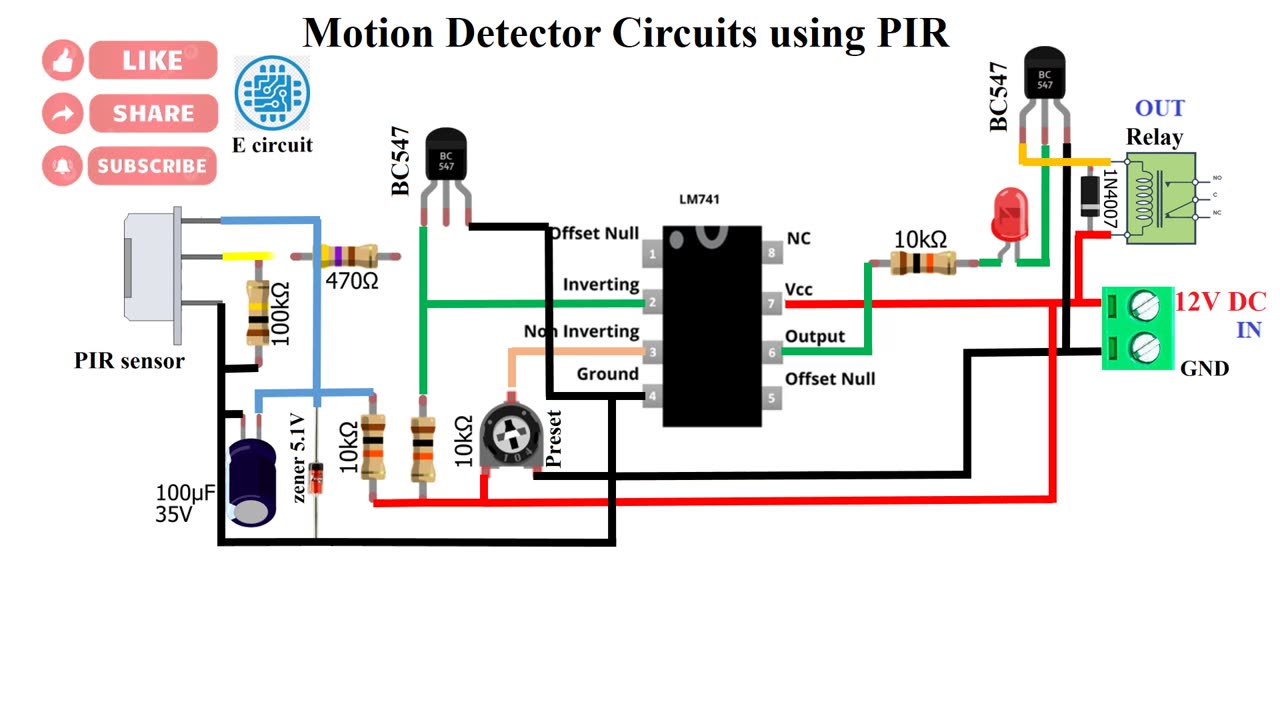Premium Only Content

Motion Detector Circuits using PIR
Hey everyone, welcome to the #E circuit! Today, we're diving into the fascinating world of motion detection with PIR sensors. You've probably seen these used in home security systems and automatic lighting – they're pretty cool little devices.
So, what exactly is a PIR sensor? Well, PIR stands for Passive Infrared. The key word here is "passive." Unlike some sensors that emit their own signals, PIR sensors simply detect infrared radiation that's already present in the environment. Think of it like this: everything with a temperature above absolute zero emits infrared light, including us humans. PIR sensors are specifically designed to pick up changes in this infrared radiation, particularly those caused by the movement of warm bodies.
How does it work? Inside the sensor, there's a special material that generates an electrical charge when it's exposed to infrared radiation. When a warm object, like a person, moves within the sensor's field of view, the amount of infrared radiation hitting the sensor changes. This change in radiation causes a change in the electrical charge, which the sensor then detects.
This tiny electrical signal is then amplified by a built-in circuit, usually involving a Field Effect Transistor (FET). This amplified signal is what triggers the alarm or other connected device.
In this video, we're going to explore five different ways to build motion detector circuits using op-amps and transistors, which are common electronic components. We'll also take a closer look at the pinout of a very popular PIR sensor, the RE200B, so you can easily integrate it into your own projects.
Hey everyone, welcome to the #E circuit! Today, we're diving into the fascinating world of motion detection with PIR sensors. You've probably seen these used in home security systems and automatic lighting – they're pretty cool little devices.
So, what exactly is a PIR sensor? Well, PIR stands for Passive Infrared. The key word here is "passive." Unlike some sensors that emit their own signals, PIR sensors simply detect infrared radiation that's already present in the environment. Think of it like this: everything with a temperature above absolute zero emits infrared light, including us humans. PIR sensors are specifically designed to pick up changes in this infrared radiation, particularly those caused by the movement of warm bodies.
How does it work? Inside the sensor, there's a special material that generates an electrical charge when it's exposed to infrared radiation. When a warm object, like a person, moves within the sensor's field of view, the amount of infrared radiation hitting the sensor changes. This change in radiation causes a change in the electrical charge, which the sensor then detects.
This tiny electrical signal is then amplified by a built-in circuit, usually involving a Field Effect Transistor (FET). This amplified signal is what triggers the alarm or other connected device.
In this video, we're going to explore way to build motion detector circuits using op-amps and transistors, which are common electronic components.
So, if you're interested in learning how to build your own motion-sensing devices, stick around! We're going to break it all down step by step.
-
 LIVE
LIVE
Game On!
11 hours agoChiefs Dynasty OVER, New Longest FG RECORD, and Patriots Are Winning The Super Bowl!
321 watching -
 LIVE
LIVE
The Bubba Army
2 days agoIS AMERICA OVER TRUMP? - Bubba the Love Sponge® Show | 11/03/25
3,688 watching -
 48:57
48:57
Man in America
16 hours agoThe Sinister Reason They Put Fluoride in Everything w/ Larry Oberheu
343K86 -
 1:06:56
1:06:56
Sarah Westall
13 hours agoAstrological Predictions, Epstein & Charlie Kirk w/ Kim Iversen
83.8K55 -
 2:06:49
2:06:49
vivafrei
22 hours agoEp. 289: Arctic Frost, Boasberg Impeachment, SNAP Funding, Trump - China, Tylenol Sued & MORE!
266K198 -
 2:56:28
2:56:28
IsaiahLCarter
17 hours ago $11.30 earnedThe Tri-State Commission, Election Weekend Edition || APOSTATE RADIO 033 (Guest: Adam B. Coleman)
45.7K7 -
 15:03
15:03
Demons Row
12 hours ago $13.21 earnedThings Real 1%ers Never Do! 💀🏍️
61.7K22 -
 35:27
35:27
megimu32
16 hours agoMEGI + PEPPY LIVE FROM DREAMHACK!
181K15 -
 1:03:23
1:03:23
Tactical Advisor
19 hours agoNew Gun Unboxing | Vault Room Live Stream 044
266K41 -
 19:12
19:12
Robbi On The Record
20 hours ago $25.16 earnedThe Loneliness Epidemic: AN INVESTIGATION
96.1K115